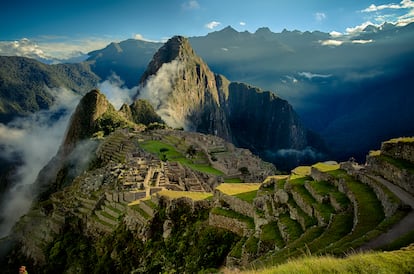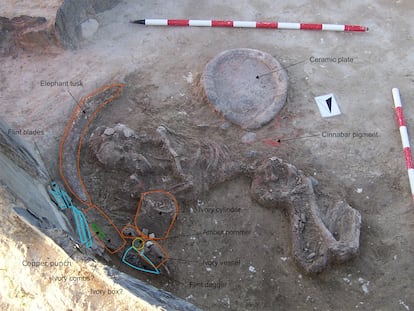The mystery of Machu Picchu’s lost gold plaque and scroll
Mayors blamed each other for the disappearance of the treasured items, which were received in 2007 when the Peruvian fortress became one of the Seven Wonders of the Modern World: 24 hours later, the plaque miraculously reappeared

Since July 7, 2007, Peruvians have commemorated the day that Machu Picchu, a feat of architecture and engineering, was chosen as one of the Seven Wonders of the Modern World. Peru followed the Lisbon ceremony on dozens of giant screens installed in town squares and parks. Jubilation reigned in a country eager for victories. The recognition promised development and a significant boost in tourism from around the world.
The New Open World Corporation organized the contest, and it received over 100 million votes on the Internet and via text messages: 77 monuments reached the semifinals. The fact that this centuries-old complex built in 1450 in the Peruvian Andes was worthy of this investiture was an act of justice, but it also represented a collective triumph for the country’s population, which did its part online.
This Monday, three days after the 16th anniversary of that historic achievement, the mayor of the District Municipality of Machu Picchu, Elvis La Torre Uñacori, made a devastating announcement: the gold plaque and scroll given to the Cusco authorities in 2007 had been lost. “Absolutely nothing has been transferred. We only have the silver plaque that is in the mayor’s office. However, we do not have the gold plaque and the scroll. We are going to file the appropriate complaint with the Attorney General’s Office to determine who is responsible,” the mayor said.
After that, the five mayors who had governed the Cusco municipality from 2007 on made a series of contradictory statements. Each official defended himself as best he could, but without giving further details about the whereabouts of the objects. According to information from Radio Programas del Perú, Darwin Baca León (2019-2022) maintained that they found a replica of the plaque in the warehouses of the Municipality of Cusco, but his administration never knew where the originals were.
Óscar Valencia (2011-2012) said that before he left office, he transferred the plaque and the scroll to his immediate successor, La Torre Uñacori, who governed temporarily for less than a year; he added that after a while, he confirmed that the treasured items were in David Gayoso García’s office (2013-2018). However, Gayoso disputed that version: “When I entered [office], there was no plaque or scroll.” Incredible as it may seem, he claims that La Torre Uñacori himself, who publicly complained about the disappearance, “never transferred these items physically, in an inventory, or in any kind of document.”
Questions then emerged about the thorny issue: Who was lying? When did the valuable pieces go missing? Why has information about their disappearance come so many years later? Then, a new character added a twist to the story. Moisés Bendezú Sandoval, the promoter of the 2007 campaign to vote for Machu Picchu as a Modern Wonder of the World, accused the mayor who first received them, Édgar Domingo Miranda Quiñones (2007-2010), of having the items. “He has [them] in his house [...] All these years, I have always demanded that he return [them] and, since he has money, I think he thought that the scroll was for him. He must still think that now,” he said.
This Tuesday, amid the bickering and a growing international scandal, the current mayor of Machu Picchu, La Torre Uñacori, made another unexpected announcement: 24 hours after it was reported missing, the gold plaque was found in the municipality’s general secretariat office. The news caused more than one jaw to drop. Apparently the gold plaque had never been lost; they just had not searched very hard for it. “They do not exist in the transfer act. They have no code. Therefore, we did not know where we could find it. It happens to be in the shape of a vine. I imagine that it has been on a shelf between files and books,” said La Torre Uñacori. But was it really an oversight, or did someone spooked by the media attention quietly return it?
Regardless, the search continues because the scroll has not turned up yet. “It has not been found despite the fact that I have made officials stay up late [looking for it]. They have been searching since 7 a.m. today [Tuesday]. If it is not found, the prosecutor will take legal action,” added La Torre Uñacori. Meanwhile, the Mixed Provincial Prosecutor’s Office of Machu Picchu opened a preliminary investigation against those responsible for the alleged crime of simple theft while the truth of the matter remains unclear.
Machu Pichu — the jewel of Tahuantinsuyo — was built under the Inca leader Pachacutec. It gained prestige at the beginning of the 20th century and it is now the tourism emblem of Peru. Currently, it receives around 4,500 visitors per day; the Ministry of Foreign Trade and Tourism plans to increase that number to 6,000 in the next few years. UNESCO declared the historic sanctuary a World Heritage Site in 1983.
Sign up for our weekly newsletter to get more English-language news coverage from EL PAÍS USA Edition
Tu suscripción se está usando en otro dispositivo
¿Quieres añadir otro usuario a tu suscripción?
Si continúas leyendo en este dispositivo, no se podrá leer en el otro.
FlechaTu suscripción se está usando en otro dispositivo y solo puedes acceder a EL PAÍS desde un dispositivo a la vez.
Si quieres compartir tu cuenta, cambia tu suscripción a la modalidad Premium, así podrás añadir otro usuario. Cada uno accederá con su propia cuenta de email, lo que os permitirá personalizar vuestra experiencia en EL PAÍS.
¿Tienes una suscripción de empresa? Accede aquí para contratar más cuentas.
En el caso de no saber quién está usando tu cuenta, te recomendamos cambiar tu contraseña aquí.
Si decides continuar compartiendo tu cuenta, este mensaje se mostrará en tu dispositivo y en el de la otra persona que está usando tu cuenta de forma indefinida, afectando a tu experiencia de lectura. Puedes consultar aquí los términos y condiciones de la suscripción digital.
More information
Archived In
Últimas noticias
Most viewed
- Reinhard Genzel, Nobel laureate in physics: ‘One-minute videos will never give you the truth’
- Oona Chaplin: ‘I told James Cameron that I was living in a treehouse and starting a permaculture project with a friend’
- Pablo Escobar’s hippos: A serious environmental problem, 40 years on
- Why we lost the habit of sleeping in two segments and how that changed our sense of time
- The fall of a prolific science journal exposes the billion-dollar profits of scientific publishing











































